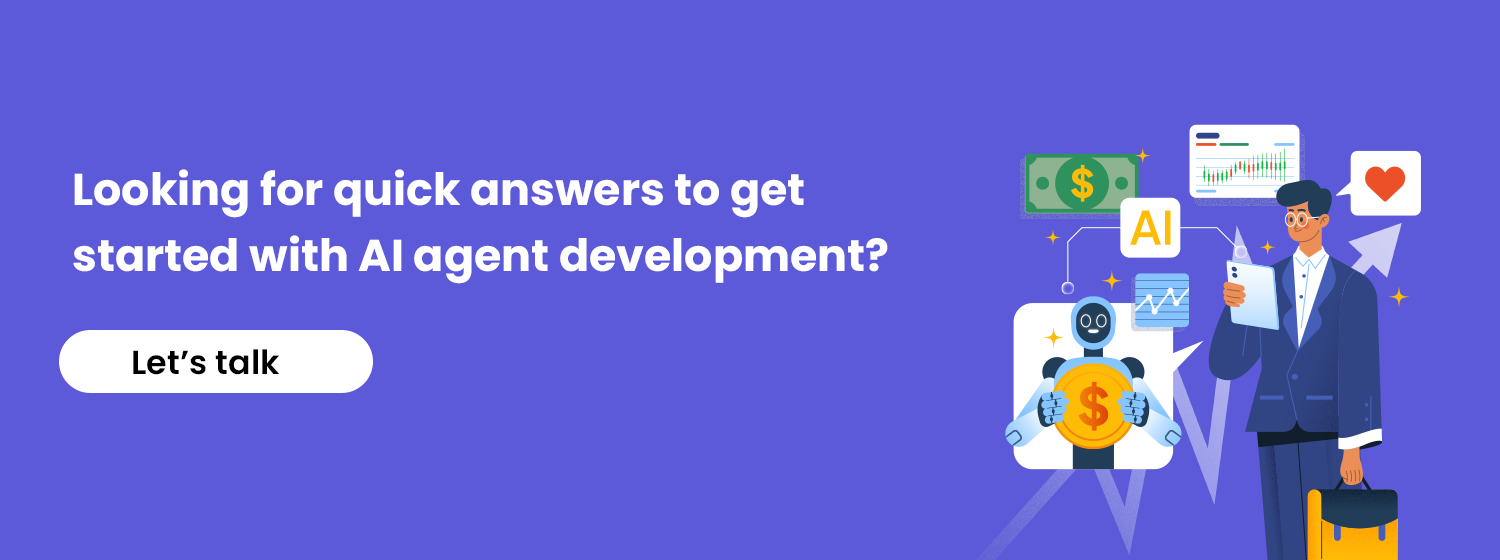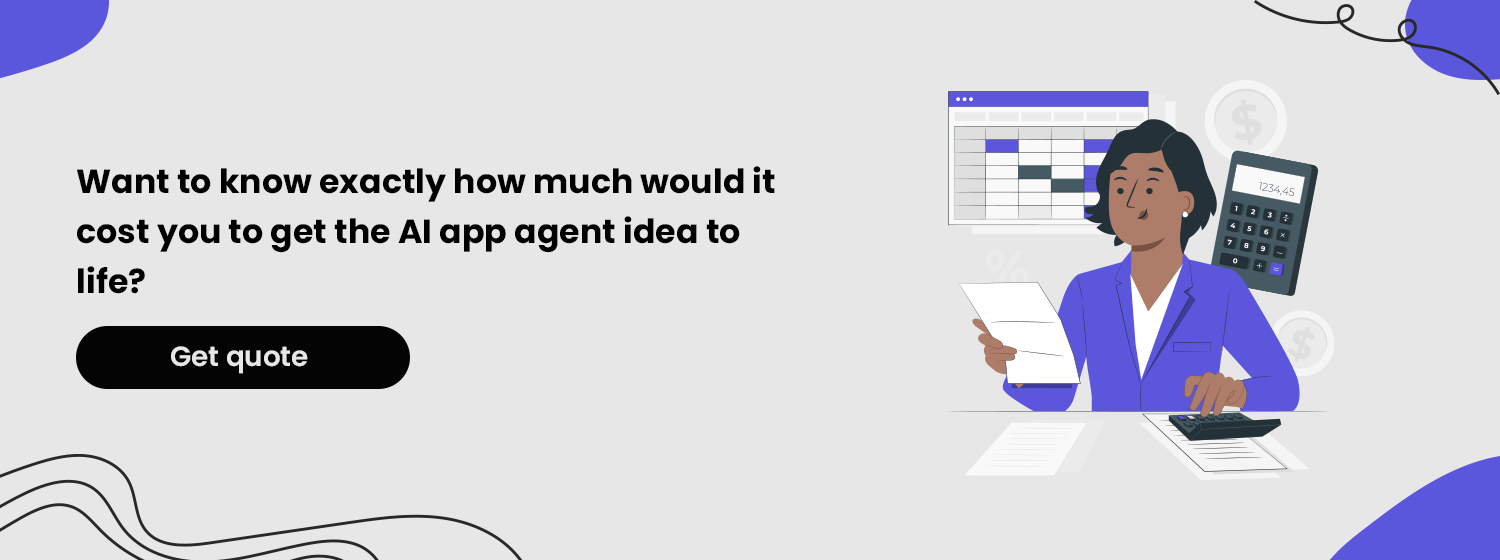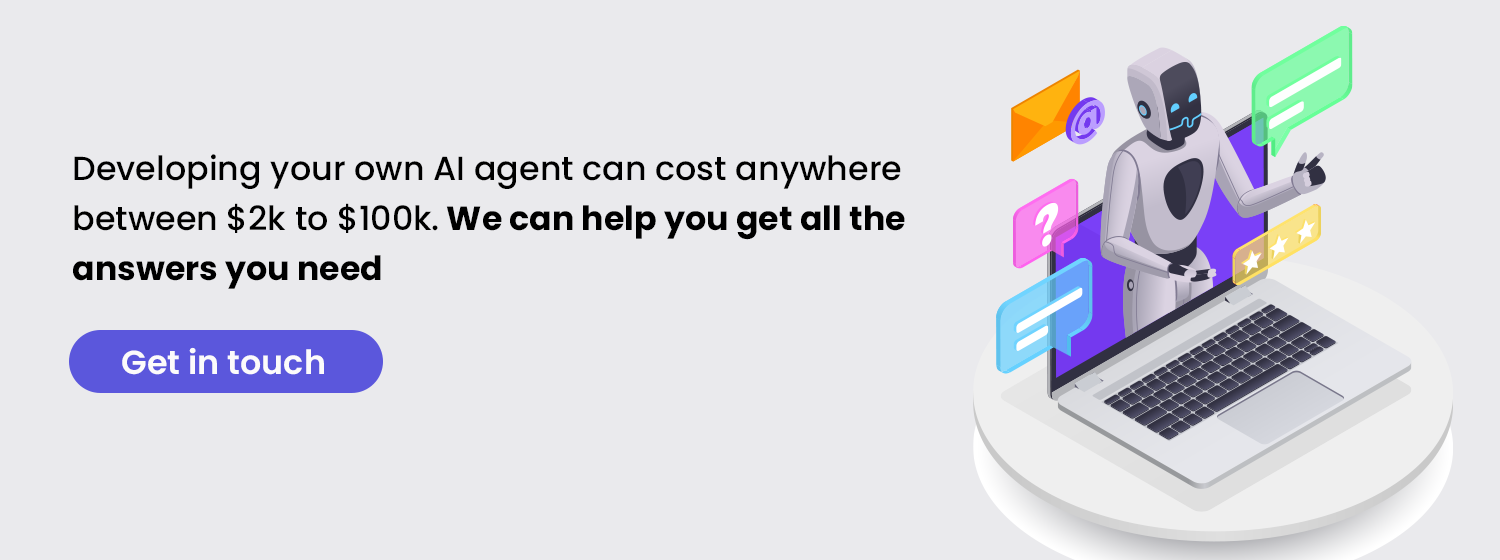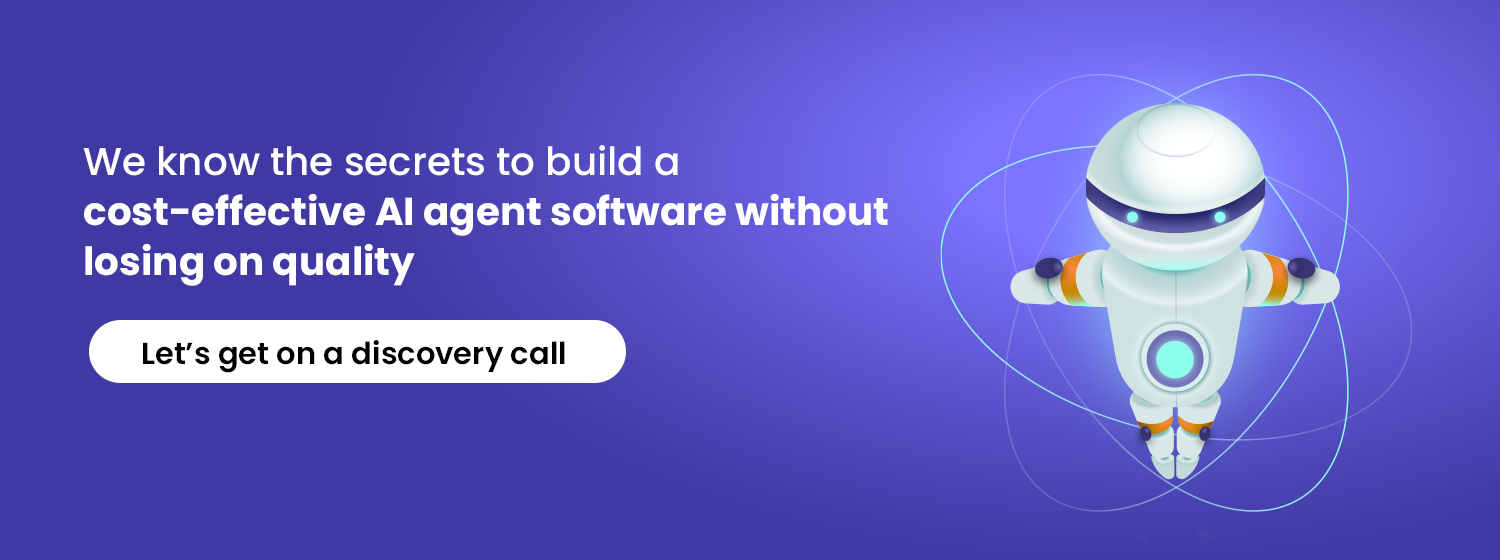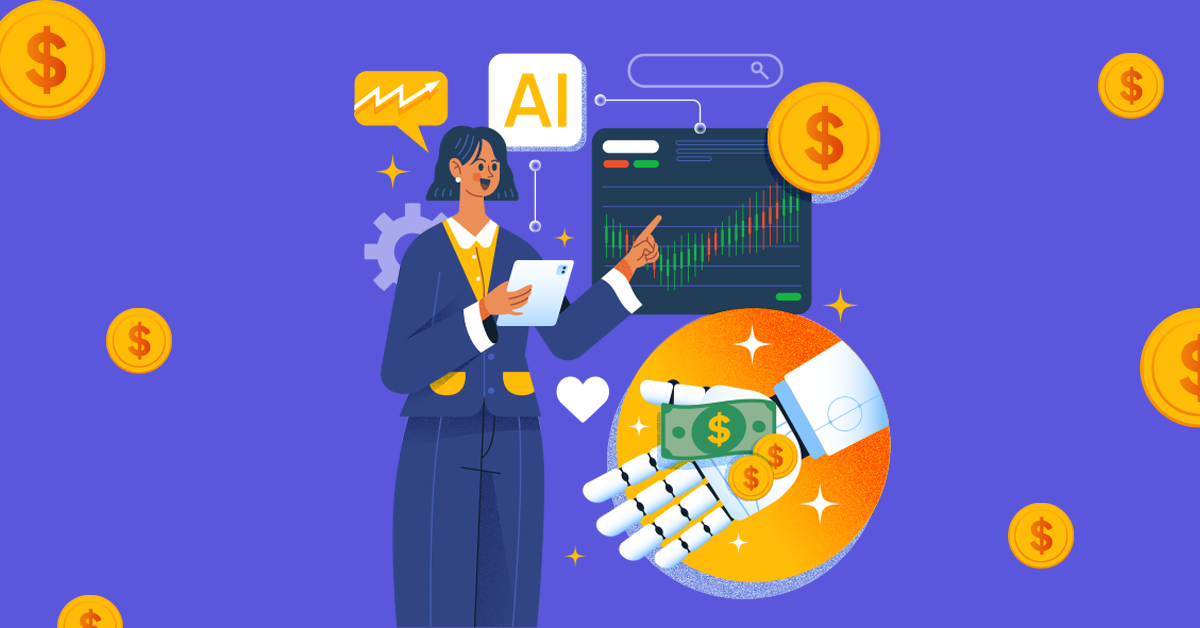
So, you’re thinking about building an AI agent. Maybe it’s that 24/7 customer service rep that never sleeps. Or a sales assistant that actually remembers every lead. Or maybe you just want to automate the stuff that eats up your team’s time and budget. Either way, you’re in good company – AI agents are quickly becoming the not-so-secret weapon for startups and growing businesses, a phenomenon clear from its projected market size of USD 52.62 billion by 2030
But then comes the question: “How much is this going to cost me?”
The truth? It depends. There’s no one-size-fits-all price tag because AI agent development spans everything from plug-and-play tools to custom-built, enterprise-grade solutions that rival Silicon Valley’s finest. That’s why understanding the cost drivers – from tech stack choices to integration needs – isn’t just helpful, it’s crucial.
In this guide, we’ll break it all down – no fluff, no jargon. Just straight-up insights to help you make smarter, faster decisions with your AI agent development cost budget in mind.
Cost-breakdown of AI Agent Development
Let’s talk numbers – because when it comes to custom AI agent development, cost isn’t just a budgeting line item. It’s a strategic decision.
The truth is, building an AI agent can cost anywhere from $5,000 to over $500,000. That wide range isn’t about guesswork – it reflects the level of complexity, customization, and intelligence you need from your AI. Whether you’re looking to deploy a simple assistant that answers FAQs or a deeply integrated, adaptive agent that can handle complex business logic, the investment will scale accordingly.
Here’s a clear AI agent development cost breakdown to help you map expectations to budget:
1. Entry-Level AI Agent: $5,000 – $15,000
This is your quickest route to automation. Using off-the-shelf platforms and pre-trained models (like ChatGPT, Dialogflow, or Rasa), developers can set up a basic conversational agent with minimal custom code.
- Best for: Early-stage startups, MVPs, internal tools
- What’s included: FAQ bots, appointment scheduling, simple customer service flows
- Limitations: Limited memory, generic responses, minimal personalization
2. Mid-Tier AI Agent: $20,000 – $100,000
This tier gives you more control. You’ll get custom-trained models, tailored dialogues, and integrations with your CRM, ERP, or proprietary backend systems. The AI can pull data, take actions, and adapt to user context.
- Best for: Growth-stage startups, SaaS platforms, productized services
- What’s included: Brand-aligned conversations, multi-channel deployment, analytics, automation workflows
- Team typically required: Backend developer, AI/ML engineer, UX specialist
3. Advanced AI Agent: $100,000 – $500,000+
This is enterprise-grade AI. Think agents that can reason, remember, and interact across departments – sometimes with voice capabilities, multilingual support, and real-time decision-making.
- Best for: Tech-forward enterprises, platform businesses, AI product companies
- What’s included: Custom LLMs, proprietary data training, infrastructure setup, full compliance layer (HIPAA, GDPR, etc.)
- Ongoing investment: Continuous learning, performance monitoring, and fine-tuning
Additional Ongoing AI Agent Development Cost
Even post-launch, AI agents incur running costs:
| Cost Type | Estimated Range | Notes |
| API usage (OpenAI, Claude, etc.) | $100–$10,000/month | Scales with usage and model complexity |
| Cloud hosting (AWS, Azure, etc.) | $200–$5,000/month | Based on traffic and data storage |
| Monitoring & maintenance | $2,000+/month | Bug fixes, security, and performance tuning |
| Model re-training and updates | Varies | Especially critical if your data or goals evolve |
There’s no universal price tag for custom AI agent development – because there’s no one-size-fits-all use case. The real question isn’t “How much does it cost?” but “What kind of value will it deliver?”
If you’re just starting out, a $10K–$20K investment might be enough to automate key workflows and test your assumptions. But if you’re building a core product feature, enhancing customer experience at scale, or replacing legacy processes with smart automation, the upfront investment will – and should – reflect that ambition.
Think of AI agents not as expenses, but as business accelerators. The cost is flexible, but the opportunity? Exponential.
Factors Affecting AI Development Cost
The wide range of AI app development services costs isn’t arbitrary. It’s shaped by multiple variables that impact the time, resources, and expertise needed to build and maintain the system. Let’s break down each major factor and how it affects your bottom line:
1. Type of AI Agent (Chatbot, Voice Bot, Multi-Modal)
The kind of AI agent you build plays a foundational role in determining the AI agent development cost.
- Chatbots are the most common and typically the most affordable. They rely on text-based interfaces – think web support widgets or in-app assistants. These are relatively faster to build and cheaper to deploy, especially if you’re using existing frameworks like Dialogflow, Rasa, or GPT-based APIs.
- Voice bots, on the other hand, add complexity. They require speech-to-text (STT) and text-to-speech (TTS) engines, natural language understanding (NLU), and a smooth conversational experience that works with varying accents, intonations, and real-time feedback. Tools like Amazon Lex or Twilio Voice can help, but building a fluid, real-time voice bot demands more compute power, latency optimization, and testing – pushing costs higher.
- Multi-modal agents take it even further. These systems combine voice, text, image recognition, and even gestures. For example, an AI assistant that can respond to a spoken command, show visual data, and analyze camera input simultaneously. These are costly because they require multiple AI models working in tandem, extensive UX planning, and high-end infrastructure to support real-time responses across modalities.
Cost Impact:
- Chatbot: Entry-level to mid-tier ($5K–$100K)
- Voice bot: Mid to high tier ($30K–$200K+)
- Multi-modal agent: High-end only ($150K–$500K+)
2. Scope and Complexity of Tasks
The more your AI agent is expected to do, the higher the complexity – and the cost.
- A bot that answers a fixed set of questions from a predefined script is vastly different from one that can dynamically retrieve and summarize product data, escalate issues, book appointments, or learn user preferences over time.
- Adding layers like memory, context-awareness, multi-turn dialogue, or decision trees with fallback logic requires more than plug-and-play AI – it calls for serious architecture and smart workflows.
- Some AI agents even act as task managers: triggering backend workflows, updating databases, or syncing with calendars and ticketing systems in real time. Each task layer increases dev hours, testing cycles, and ongoing monitoring requirements.
Cost Impact:
- Simple logic: $5K–$20K
- Moderate complexity: $20K–$100K
- High complexity (adaptive, reasoning agents): $100K+
3. Pre-Trained Models vs. Custom Training
- Pre-trained models like OpenAI’s GPT, Meta’s LLaMA, or Google’s PaLM drastically reduce development time and cost. These models are trained on massive datasets and are accessible via APIs. You pay for usage and focus more on fine-tuning prompts and user flows than building from scratch.
- Custom training, on the other hand, is a heavier lift. If your AI agent needs to understand niche terminology, operate in regulated domains like healthcare or finance, or learn from proprietary internal data, you’ll need to retrain or fine-tune a model on your specific datasets.
- Training models from scratch (true custom AI) involves data curation, annotation, compute-intensive training runs, and expert involvement across data science, MLOps, and AI ethics. It’s powerful – but expensive.
Cost Impact:
- Pre-trained: $0.01–$0.10 per interaction + dev time
- Fine-tuned: +$20K–$100K for data processing and model training
- Custom model from scratch: $200K+
4. Integration with Internal Systems (CRM, ERP, etc.)
The value of an AI agent often lies in its ability to do something useful – and that typically means talking to your existing systems.
- Connecting to platforms like Salesforce, HubSpot, SAP, or your in-house database adds complexity. You need secure APIs, real-time data flows, and often middleware or transformation logic.
- Each integration comes with its own authentication mechanisms, rate limits, and edge cases. The more systems your AI agent touches, the more effort it takes to test, monitor, and maintain those connections.
- If your backend systems are not API-ready or involve legacy infrastructure, costs increase exponentially due to the need for custom adapters and data standardization.
Cost Impact:
- Single modern SaaS integration: $5K–$15K
- Multiple or legacy integrations: $20K–$80K+
5. Real-Time Performance and Latency Needs
If your AI agent needs to operate in real-time – say, answering customer questions on a voice call or assisting in a live support window – performance becomes a major concern.
- Real-time applications require optimized backend architecture, low-latency data processing, and fast model inference. This often calls for GPU-accelerated servers, edge computing setups, or latency-optimized cloud infrastructure.
- You’ll also need robust failover strategies and fallback responses if your AI system can’t deliver an answer in milliseconds.
- The testing, scaling, and observability tools required for this level of responsiveness can significantly impact cost.
Cost Impact:
- Standard response apps: Minimal additional cost
- Real-time systems (e.g., call centers, voice agents): +$10K–$100K depending on concurrency and load
6. Data Privacy, Compliance, and Security Layers
If your AI agent handles sensitive information – think health records, financial data, or personal identifiers – you’ll need to build in strong data governance and compliance protocols.
- Regulatory standards like HIPAA, GDPR, SOC 2, and CCPA aren’t optional. Ensuring compliance means encrypting data at rest and in transit, implementing access controls, maintaining audit trails, and having data retention/deletion policies in place.
- If your AI agent uses third-party APIs, you’ll need to validate their compliance stance, too – especially when transmitting user data.
- Security audits, penetration testing, and policy documentation will add to both upfront and ongoing costs.
Cost Impact:
- Basic compliance layer: $10K–$30K
- Full enterprise-grade security stack: $50K–$150K+
7. Frontend and UX Requirements
Your AI agent’s interface is what users actually see – and poor UX can kill a good AI system.
- Simple web chatbots embedded on a homepage are cheap to design and deploy. But if you’re building a fully branded AI assistant with a custom frontend (mobile app, dashboard, or voice interface), the design and frontend development work expands quickly.
- UX matters even more in multi-modal or voice-based agents where tone, pacing, accessibility, and fail states need to be carefully thought through.
- Considerations like animation, responsiveness, multilingual support, and visual integrations with other systems also add to the development lifecycle.
Cost Impact:
- Basic UI (web widget or chatbot): $2K–$10K
- Custom frontend, mobile or voice interface: $20K–$100K+
What AI Agent Development Cost Could Look Like in Practice?
You’ve seen the broad factors. You’ve seen the ballpark figures. But what does AI agent development actually cost in the real world?
Let’s take a closer look at three very different business contexts when you develop AI software – a startup, a mid-sized healthcare company, and a growing e-commerce brand. Each example reflects the real decisions entrepreneurs make: what to build, what to integrate, what to prioritize, and what trade-offs come with it.
These scenarios don’t just help benchmark costs. They also reveal how complexity, industry, compliance, and scale directly affect your AI investment. Whether you’re bootstrapping or scaling, this is what you’re realistically looking at.
Example 1: Startup Building a Sales Assistant Bot
A SaaS startup wants to build a web-based AI agent that helps qualify inbound leads, answer common product questions, and book demos. It’s a simple chatbot, integrated with their website and CRM (HubSpot), trained on product documentation and FAQs.
Key Build Decisions:
- Type: Text-only chatbot
- Complexity: Moderate (lead qualification, intent-based flows, scheduling integration)
- Model: GPT-based, API-driven (no custom training)
- Integration: CRM, Google Calendar
- UX: Simple web chat widget
- Compliance: No major regulatory needs
Estimated Cost Breakdown:
- Chatbot logic and flows: $10K
- API integrations (HubSpot, Calendar): $5K
- Prompt engineering and testing: $5K
- Web UI/embedding: $2K
- Total: $20K–$25K
Timeline: 4–6 weeks
Ongoing costs: GPT-API usage fees, basic monitoring, and bug fixes
Example 2: Mid-Sized Healthcare Company Building a HIPAA-Compliant Virtual Assistant
A regional healthcare provider wants to automate patient queries, appointment booking, prescription refill requests, and basic symptom triage – all within strict HIPAA-compliant boundaries.
Key Build Decisions:
- Type: Voice + text agent
- Complexity: High (multi-turn dialogue, real-time database lookup, contextual memory)
- Model: Fine-tuned LLM (on anonymized clinical scripts)
- Integration: EHR system, appointment management, patient portal
- Compliance: HIPAA, data encryption, audit trails
- UX: Multichannel interface (web and phone line)
Estimated Cost Breakdown:
- Voice + chatbot development: $40K
- Custom model fine-tuning: $50K
- Secure integration with EHRs and portals: $30K
- HIPAA security layer (encryption, compliance testing): $40K
- Frontend and accessibility (voice UX, mobile compatibility): $25K
- Total: $180K–$220K
Timeline: 3–4 months
Ongoing costs: Hosting, compliance reviews, model updates, secure API management
Example 3: E-Commerce Brand Deploying a Multilingual AI Support Agent
A fast-growing D2C brand operating across the US, Latin America, and Europe wants to automate customer service in English, Spanish, and French. When you develop AI software of this kind, it should handle order tracking, returns, product FAQs, and simple refund processes.
Key Build Decisions:
- Type: Multilingual text chatbot
- Complexity: Moderate to high (language switching, dynamic responses, sentiment-aware)
- Model: GPT with multilingual capabilities via API
- Integration: Shopify backend, shipping APIs, Zendesk
- UX: Custom chatbot embedded in website and mobile app
- Compliance: Basic (GDPR-compliant for EU users)
Estimated Cost Breakdown:
- Multilingual dialogue design and testing: $20K
- Shopify, Zendesk, and shipping integrations: $15K
- Prompt logic for regional variations: $10K
- Custom frontend and branding: $10K
- GDPR compliance and user consent layers: $10K
- Total: $60K–$70K
Timeline: 6–8 weeks
Ongoing AI development pricing: Translation tuning, customer feedback loops, LLM API usage
Build vs. Buy: Is It Cheaper to Use AI Platforms?
This is the question every founder or product leader runs into early: Do we build our AI agent from scratch, or assemble it using existing tools and APIs?
The short answer: The AI development pricing depends on how unique your use case is, how fast you need to go to market, and how much control you want.
Building from scratch gives you complete flexibility – custom workflows, tighter integrations, and fine-tuned experiences. But it comes at a higher upfront cost and longer timelines. It’s typically best suited for businesses in regulated industries, companies with in-house AI talent, or products where the agent itself is the differentiator.
On the other hand, using foundational APIs and agent frameworks (like OpenAI Assistants or open-source stacks) can get you to market faster and cheaper with considerably less budget going in AI integration cost. These routes work well for common use cases like customer support, lead gen, or internal productivity tools. But they come with trade-offs: limited customization, dependency on third-party performance, and ongoing API costs.
The real cost to develop AI software isn’t just in dollars – it’s in flexibility, ownership, and long-term scalability. If your agent is core to your product strategy, you’ll likely outgrow plug-and-play tools quickly.
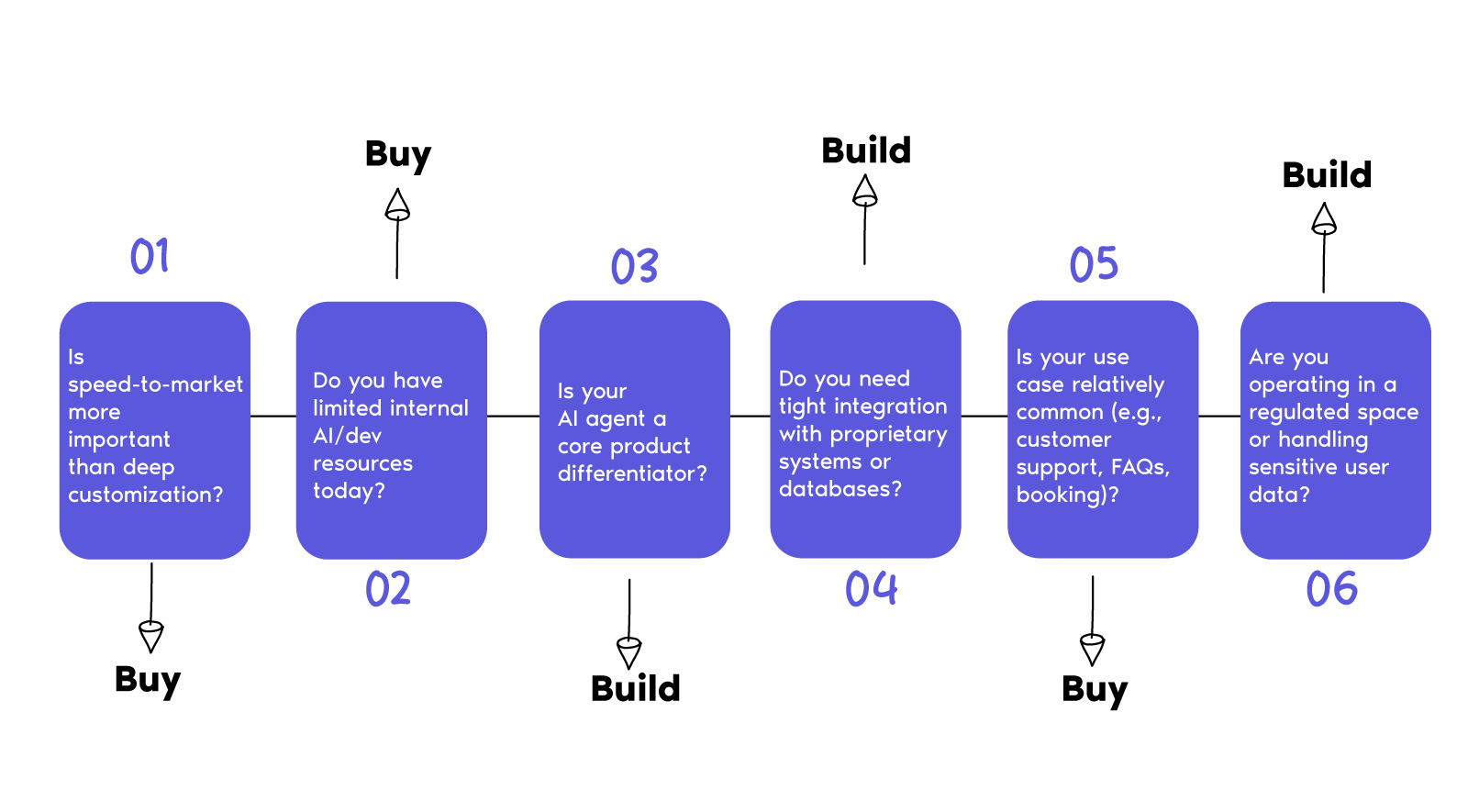
Tips to Manage the Cost to Develop AI Software Without Compromising Quality
Custom AI agent development doesn’t have to break the bank – but they will if you treat development like a black box. Whether you’re outsourcing or managing an internal team, smart cost management starts with making the right decisions early. Here’s how to stay in control without cutting corners:
1. Start With a Razor-Sharp Use Case
Avoid vague goals like “automate support” or “make sales easier.” Instead, define clear user tasks: answer product FAQs, qualify leads, schedule appointments. A tight scope reduces development bloat and keeps your team focused.
2. Build in Layers, Not All at Once
Don’t over-engineer from day one. Launch a core MVP that handles 60–70% of the most frequent user needs. Then expand. This staged approach helps you validate assumptions before sinking more resources.
3. Leverage APIs Smartly
You don’t need to reinvent the wheel. Use APIs for speech-to-text, language translation, or pre-trained LLMs when available – but be strategic. Some tasks are better off custom-built if you care about performance or data privacy.
4. Prototype Without Code First
Before your dev team writes a single line, test the user experience using tools like Typeform, Figma, or even a Wizard-of-Oz workflow (where a human mimics the AI behind the scenes). You’ll uncover flaws before paying engineers to build them in.
5. Monitor Prompt Engineering Time
This one’s sneaky. Prompt tuning can spiral into weeks of expensive trial and error if not scoped right. Set guardrails: how many use cases, how many iterations, and who signs off.
6. Choose Dev Partners With Domain Knowledge
A generic dev shop might charge less upfront, but they’ll spend more time ramping up. If you’re in fintech, health, or e-comm, pick teams who already understand the ecosystem – it saves months.
7. Budget for Post-Launch Maintenance
AI agents are not fire-and-forget. You’ll need ongoing support for model drift, API changes, UX updates, and new user data. Factor in at least 15–20% of the initial build cost annually for maintenance.
How Codingworkx Helps You Build AI Agents Without Burning Through Budget
At Codingworkx, we work with startups and scaling companies who want powerful AI agents – without the runaway costs that usually come with custom builds.
Here’s how we keep AI app development services lean, focused, and future-proof:
1. Strategy Before Code
We start with a discovery sprint to define the use case, workflow logic, and performance goals. That way, you’re not paying for features you don’t need or models that won’t scale.
2. Smart Stack Decisions
Our team doesn’t blindly default to the latest shiny tool. We evaluate whether to use foundational models, open-source frameworks, or hybrid solutions – based on your goals, speed needs, and budget. No lock-ins, no bloat.
3. Domain-Aligned Teams
We match you with engineers and AI specialists who understand your space – healthcare, e-comm, SaaS, or finance. This minimizes back-and-forth and slashes integration overhead.
4. Modular Development, Not Monoliths
We build in layers – starting with an MVP that proves value fast. From there, we layer in features that actually matter to your users. Each phase is budgeted and trackable.
5. Transparent Costing & Predictable Burn
Every sprint is scoped with clear deliverables and cost brackets. You’ll never get blindsided by vague “R&D” charges or excessive experimentation loops.
6. Post-Launch Support That Doesn’t Suck
Once your agent is live, we stick around. Monitoring, refining prompts, improving edge-case performance – we handle the iterations, while you focus on scale.
Bottom line: Codingworkx is not a dev shop that just takes specs and builds. We’re your AI product partner – optimizing for value, speed, and control every step of the way.
FAQs
Q. What is the average cost of developing an AI agent?
Ans. The average cost ranges from $25,000 to $150,000+, depending on the complexity, industry, and whether you’re building from scratch or using existing APIs. A simple chatbot MVP might cost around $20K–$40K, while an enterprise-grade AI agent with integrations, compliance layers, and custom workflows can go well above $100K.
Q. What factors influence the cost of AI agent development?
Ans. Several things drive the development and AI integration cost
- Type of agent (chatbot, voice bot, multimodal)
- Scope of tasks and decision-making complexity
- Use of pre-trained models vs custom model training
- Real-time performance or latency requirements
- System integrations (CRM, ERP, databases)
- Security, compliance (like HIPAA or GDPR)
- UX layer (basic interface vs branded, responsive frontend)
Q. Is AI agent development expensive for startups?
Ans. Not necessarily. Startups can reduce cost by:
- Narrowing the use case
- Using pre-trained models or open-source stacks
- Limiting integrations at launch
- Releasing in stages (MVP first, then scale)
At Codingworkx, we’ve helped early-stage teams get working agents live for under $30K with smart architecture choices.
Q. How much does it cost to build a custom AI agent in 2025?
Ans. Custom AI agent builds in 2025 typically fall into these ranges:
- $25K–$40K → MVPs using APIs or agent frameworks
- $50K–$90K → Mid-tier builds with some custom logic and integrations
- $100K+ → Fully custom builds with compliance, backend integrations, and domain-specific AI tuning
Expect pricing to stay stable as tooling improves – but team expertise still drives most of the cost.
Q. Do pricing models differ for AI agents vs chatbots?
Ans. Yes. Traditional chatbots are rules-based and cost less to build – typically $5K–$15K. AI agents, especially those powered by LLMs or multi-modal inputs, require more design, logic modeling, and testing. That pushes costs higher, but also delivers more value through adaptability and automation.
Q. Does Codingworkx offer fixed pricing for AI agent development?
Ans. Yes, we offer both fixed-price milestone projects and time-boxed sprints, depending on your preference. For well-scoped MVPs, we give a clear fixed quote. For evolving or experimental builds, we define a sprint scope and deliverables, so you stay in control of burn and velocity.
Q. How long does AI agent development typically take?
Ans. Timelines vary by scope:
- 2–4 weeks → Simple AI assistants with limited use cases
- 6–10 weeks → Mid-level agents with integrations or training needs
- 12–16 weeks → Custom enterprise-grade builds with compliance, edge case handling, and scale
We break builds into phases so you can go live early and layer in features as you grow.

